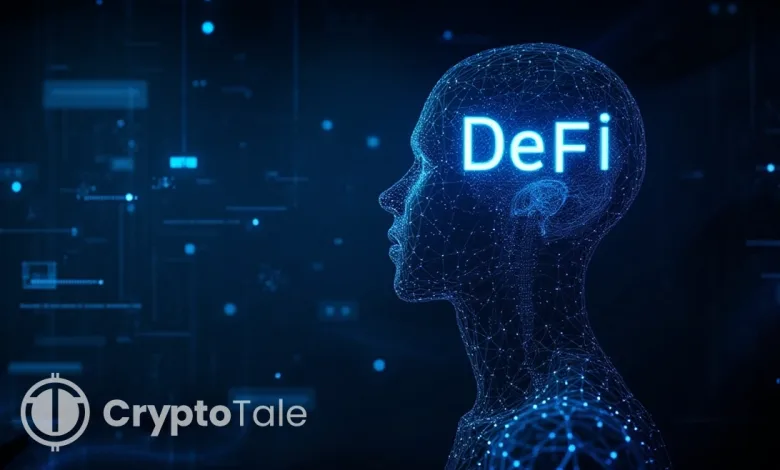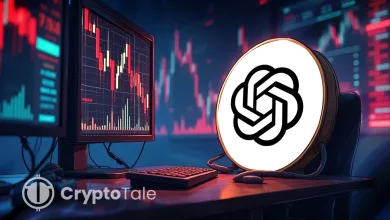How AI is Revolutionizing Decentralized Finance and Market Making

Decentralized finance has expanded over just a few years from a small experiment within the crypto world to a broad ecosystem where billions of dollars are swapped each day without a traditional bank, broker, or clearing house. In mid-2025, research had estimated that the total value locked (TVL) of all DeFi protocols was approximately $123.6 billion, which was 41% more than in the prior year.
DeFiLlama data shows TVL surged through the summer, peaking at about $172B in early October 2025, the highest level since late 2021. The rally did not last. A series of smart‑contract exploits and risk‑off market sentiment caused liquidity to flee; TVL slid to roughly $121 billion by mid‑November, with Ethereum’s own TVL falling to about $65 billion. These dramatic swings underscore both the promise and fragility of DeFi.
On the horizon stands another transformative force: artificial intelligence (AI). Just as DeFi removes intermediaries through smart contracts, AI brings predictive analytics, pattern recognition, and automation to financial decision‑making.
This article explores how these technologies intersect, focusing on automated market makers (AMMs), algorithmic trading, risk management, yield optimisation, and the regulatory and security implications of embedding AI into decentralized markets.
Conventional AMMs and Their Limitations
Decentralized exchanges such as Uniswap popularised the automated market maker model. Instead of matching buyers and sellers through an order book, AMMs rely on liquidity pools funded by users.
Prices are determined by a mathematical formula, usually the constant‑product rule x × y = k, that keeps the product of the two token reserves constant. Liquidity providers earn a share of trading fees, but several structural issues limit efficiency:
- Unused Capital and Slippage: Because liquidity is spread across a wide price range, only a small portion of the pool is actively used at any given time. Large trades move the reserve ratio, causing slippage, the difference between the expected and executed price.
- Impermanent Loss: When the price ratio of pooled tokens diverges from the deposit ratio, liquidity providers may end up with less value than if they had simply held the tokens. The Binance academy notes that the larger the price change, the greater the impermanent loss, and warns that providers could lose money relative to “hodling”. Pools containing stable tokens reduce this risk, but even stablecoins can de-peg.
- Risk Exposure: Unpredictable volatility can leave providers with disproportionate shares of the depreciating asset, eroding returns.
These challenges have not prevented AMMs from flourishing, but they do highlight the need for more adaptive mechanisms.
Related: How to Use AI Crypto Trading Bots for Smarter, Faster Trades?
AI as a Catalyst for Advanced AMMs
Artificial intelligence introduces adaptability into a world defined by static equations. Whereas traditional AMMs distribute liquidity evenly across price ranges, AI can concentrate liquidity where it will be used. The machine‑learning models can analyse on‑chain behaviour and transaction patterns to assess risk. Applying these insights to AMMs enables several innovations:
- Predictive Liquidity Placement: By analysing historical trades, order‑flow, and even social‑media sentiment, AI can forecast where future trades are likely to occur. Liquidity can then be pre‑positioned in these price bands, reducing slippage and increasing fee revenue. Modern research prototypes employ reinforcement‑learning agents that learn to adjust pool parameters dynamically as conditions change.
- Adaptive Fee Structures: When AI anticipates heightened volatility, it can raise trading fees to compensate liquidity providers for risk; during calm periods, it can lower fees to attract volume. Such flexibility improves capital efficiency and helps mitigate impermanent loss.
- Risk‑Aware Withdrawal Triggers: AI can monitor price deviations and market instability to signal when liquidity should be temporarily withdrawn. The ability to exit a pool before a sharp price movement protects providers from outsized impermanent loss. This is particularly valuable in times of exploit‑driven volatility (e.g., the Balancer exploit that drained over $120 million.
By integrating AI with AMMs, the sector moves beyond static formulas toward self‑learning markets that adjust to behaviour in real time. Such systems remain experimental, but pilot projects illustrate how machine intelligence could enhance DeFi infrastructure.
AI-Driven Trading Automation
Trading bots were among the earliest AI applications in crypto. Early versions executed straightforward instructions such as buying when a token crossed a moving average. Today’s systems ingest terabytes of data, order‑book snapshots, on‑chain metrics, news feeds, and social‑media chatter, and use machine‑learning techniques to identify patterns.
In addition, AI‑powered trading bots can analyse on‑chain transactions and social media sentiment to make real‑time decisions. By processing signals across decentralized exchanges and centralized markets simultaneously, these bots can anticipate swings and route orders to the venue offering the best execution. Sophisticated models perform portfolio rebalancing and dynamic hedging, adjusting exposures as volatility shifts. In a DeFi context, these tools tighten spreads and improve liquidity, benefiting all participants.
Institutional trading volume underscores the importance of automation. Analysts also report that centralized exchanges processed trillions of dollars in crypto volume during the year, with a growing share executed by algorithmic systems. AI’s ability to parse data and react faster than human traders offers a competitive edge, but it also raises concerns about over‑fitting models to past conditions and herding behaviour if many bots follow similar signals.
AI-Powered Risk Management and Security
DeFi’s openness is a double‑edged sword: permissionless access invites innovation but also exposes users to exploits and fraud. AI can augment risk management in several ways:
- Anomaly Detection and Fraud Prevention: According to analysts, AI‑powered anomaly detection systems can spot unusual transaction activity, block suspicious wallets in real time, and protect users from multi‑million‑dollar breaches.
- Credit and Collateral Analytics: Traditional credit scoring does not apply in pseudonymous markets. AI can analyse wallet histories, transaction frequencies, and cross‑protocol interactions to predict default probabilities. Platforms can then adjust collateral requirements dynamically, increasing capital efficiency without compromising safety.
- Stress Testing and Liquidity Modelling: AI can simulate extreme market scenarios and test how protocols respond, helping designers strengthen smart‑contract logic. It can also monitor pool health metrics, such as liquidity depth and utilization rates, to foresee when a pool might become imbalanced and require intervention.
The November 2025 market turmoil illustrates why such systems are necessary. Following the Balancer and Stream Finance exploits, Ethereum’s TVL dropped to $65 billion, and total DeFi TVL slid from around $150 billion to below $130 billion. AI‑driven risk controls could have flagged unusual withdrawals or abnormal routing patterns earlier, potentially limiting damage.
Yield Optimization and Democratization of DeFi
Providing liquidity and staking yields can be complex: users must decide which pools to join, monitor changes in fees and token prices, and rebalance positions as market conditions evolve. AI can simplify this experience:
- Intelligent Yield Strategies: Algorithms can scan thousands of pools to identify where returns are highest, adjusted for risk. During periods of heightened volatility, AI may recommend withdrawing from unstable pools and re‑entering after volatility subsides. Because AI models operate 24/7, they can capture fleeting arbitrage opportunities that a human might miss.
- Personalized Portfolios and Robo‑Advisors. Machine‑learning systems can tailor portfolios to a user’s risk tolerance, automatically allocating between lending, staking, and liquidity provision. Furthermore, AI enables hyper‑personalization, such as customised investment portfolios and smart notifications for high‑yield opportunities.
- Lowering Barriers For Newcomers. AI‑driven interfaces can abstract away complexity; users simply deposit assets and let the platform handle the mechanics. This could broaden participation beyond tech‑savvy early adopters.
Related: Regulators vs Protocols: Who’s Sketching the Blueprint for Crypto’s Future?
Security and Regulatory Challenges
Despite its advantages, integrating AI into DeFi introduces new risks:
- Data Integrity and Model Bias: AI decisions are only as good as the data they ingest. Inaccurate or manipulated inputs, such as spoofed transaction volumes or coordinated social‑media campaigns, could mislead models. Biased training data may produce unfair outcomes; for example, credit algorithms could inadvertently discriminate against certain user groups if they rely on flawed heuristics.
- Explainability and Transparency: Financial regulators increasingly demand that algorithms explain their decisions. DeFi protocols that use opaque AI may face compliance hurdles. Analysts emphasize the importance of explainable AI and warn that regulatory uncertainty remains a challenge.
- Security of AI Models: Adversaries may attempt to reverse‑engineer or exploit AI models by feeding them malicious data, a risk known as model poisoning. Decentralized governance frameworks must define who is responsible for maintaining models and responding to attacks.
- Compliance and Identity: As DeFi attracts more mainstream users, regulators may require know‑your‑customer (KYC) processes and transaction monitoring. Balancing privacy with compliance will be an ongoing tension.
Future Prospects: Cross-Chain AI and Autonomous Organizations
Looking ahead, several trends suggest that the synergy between AI and DeFi will deepen:
Cross‑Chain Liquidity Management: DeFi is spreading across multiple blockchains (Ethereum, Solana, BNB Chain, layer‑2 networks). AI tools could monitor liquidity across chains, forecast where demand will emerge, and route assets accordingly. Such systems could automatically bridge tokens to chains with higher yields or less congestion.
Autonomous DAOs: Decentralized autonomous organizations already govern many DeFi projects. Embedding AI into these DAOs could streamline governance: algorithms might evaluate proposals, predict their impact on metrics such as TVL and risk exposure, and execute decisions within approved parameters. Human oversight would still be needed to prevent alignment issues.
Quantum‑Ready Finance and Advanced Modelling: As computing power grows, AI models could incorporate quantum algorithms for complex optimization tasks, enabling more precise risk assessments and pricing models.
Integration With Traditional Finance: Banks and asset managers are exploring on‑chain products. AI‑powered DeFi platforms may offer white‑label services to traditional institutions, blending regulated finance with decentralized infrastructure.
Conclusion
Decentralized finance and artificial intelligence are both disruptive forces in their own right. DeFi has shown that financial markets can function without intermediaries, but its rapid growth has also exposed inefficiencies, liquidity constraints, and security vulnerabilities. AI, meanwhile, provides tools to predict, adapt, and protect, qualities that can address many of DeFi’s weaknesses.
The evidence from 2025 shows both the potential and the urgency of this integration: TVL surged from roughly $123.6 billion in early 2025 to $172 billion in October before falling in mid-November due to exploits and market stress. A smarter, AI‑assisted DeFi ecosystem could react more quickly to these shocks, manage liquidity more efficiently, and provide safer, more personalized services.
Yet AI is not a panacea. Its success depends on high‑quality data, robust governance, transparent models, and a regulatory framework that balances innovation with consumer protection. As DeFi continues to mature, the community must invest not only in code and capital but also in ethical AI design. Done right, the convergence of DeFi and AI could usher in a new era of finance that is both open and intelligent.





